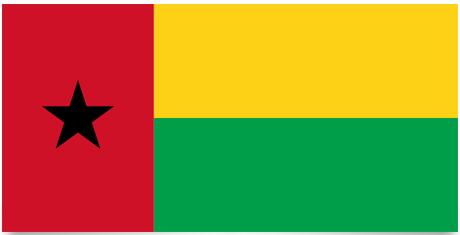Guinea-Bissau Flag and Meaning
Flag of Guinea-Bissau

Guinea-Bissau Flag Meaning
The flag of Guinea-Bissau is divided into two equal parts yellow and green and on the far right is a vertical field that is red. In the middle of the red part, there is also a black star that is five-pointed. The flag was adopted in 1973, the year before the country became independent from being a Portuguese colony. The flag was previously used by the ruling PAIGC party before it was adopted as the national flag.
The flag is inspired by the Ghanaian flag and, like many other African flags, contains the traditional pan-African colors. Red stands for the blood sacrificed in the struggle for independence, green stands for hope for the future and yellow stands for the sun’s energizing light. The star stands for a united Africa.
Guinea-Bissau Overview
| Population | 1.2 million |
| Currency | Guinea Bissau pesos |
| Area | 36.125 km² |
| Capital city | Bissau |
| Population density | 33.2 residents/km² |
| HDI location | 164 |
The land is flat and slightly hilly to the southeast. It is predominantly covered by tropical rainforest, which is crossed by rivers and canals. The swampy coastal areas are well suited for growing rice. In the eastern part of the country, agriculture – peanuts, rice, oil palms – and cattle farming are run. It has been necessary to increase agricultural exports, which has increased soil depletion, while rice cultivation has displaced parts of the coastal forests. Alternating agriculture and many forest fires contribute to reducing the country’s forest area.
The people: Balanced 27.2%; Fulani 22.9%; Malinke 12.2%; Mandiako 10.6%; Peple 10.0%; other 17.1%.
Religion: Approx. 40% are Muslims; ca. 31% are animists; and approx. 22% are Christians.
Language: Portuguese (official). The dialect crioulo which is a mixture of African languages and Portuguese is used as everyday language. Among the native languages are the most widely spoken men and fula.
Political parties: Partido Africano da Independencia da Guinea Cabo Verde (African Party of Guinea Cabo Verde Independence, PAIGC) was the land party until the end of 1991. It is led by João Bernardino Vieira. Since 1991, 10 new parties have been registered, including the Partido de Renovacão e Desenvolvimento (Party of Development and Renewal, PRD) founded by former PAIGC members. Partido para la Renovación Social (Party for Social Renewal, PRS).
Official name: República da Guiné-Bissau.
Administrative division: 8 regions, 1 autonomous sector
Capital: Bissau, 407,000 residents (2007)
Other important cities: Bafatá, 19,400 residents; Gabu, 12,200 residents (2000).
Government: José Mário Vaz, President since June 2014. Umaro Sissoco Embaló has been the country’s prime minister since November 2016. Parliament has one chamber with 102 members elected in free elections.
National Day: September 24 (Independence Day, 1973)
Armed Forces: 9,250 (2001).
Paramilitary forces: 2,000 (Gendarmerie)













































